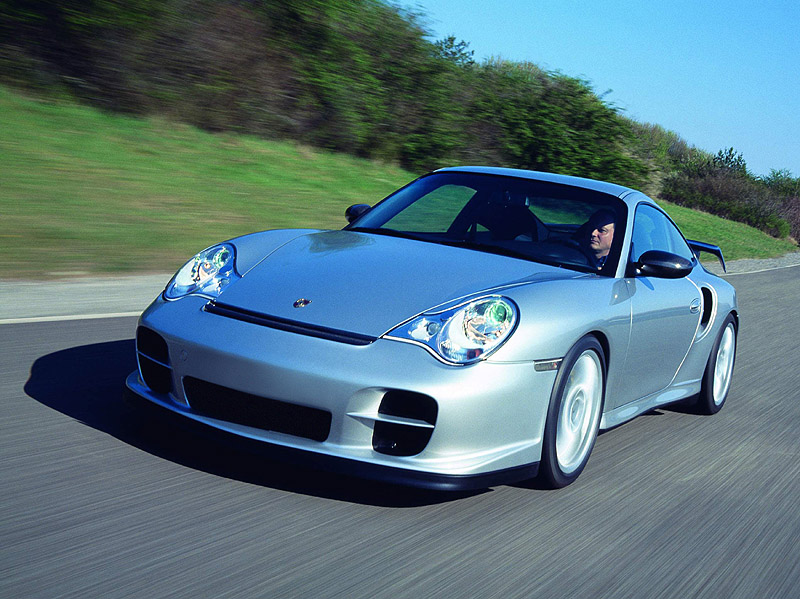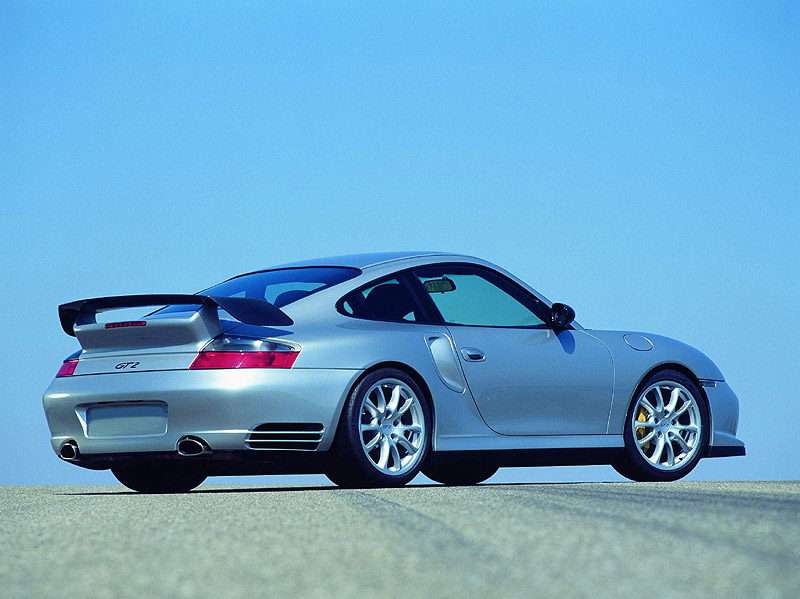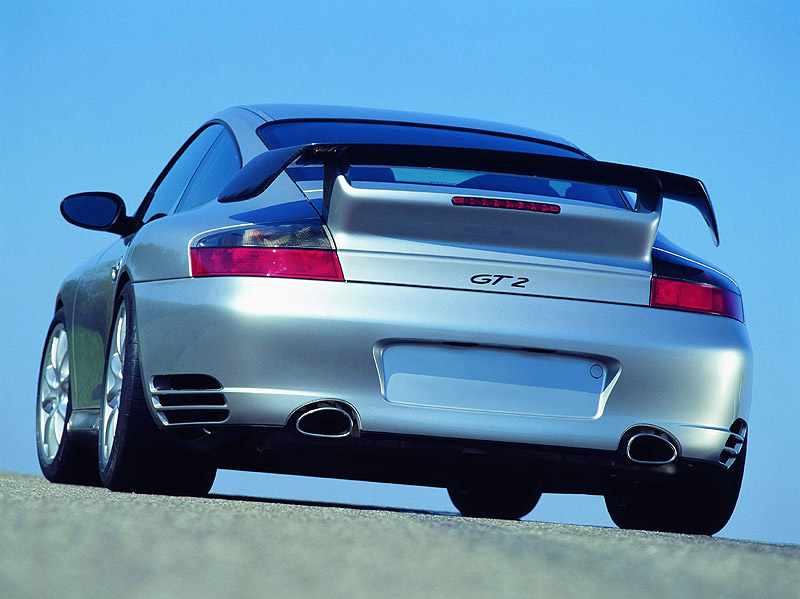.jpg)
1995: la Porsche 911 GT2
ATLANTA – Powered by Porsche’s most powerful six-cylinder “boxer” production engine, the twin-turbocharged Porsche 911 GT2 has been generously modified for 2004 with new engine, chassis, suspension and brake tuning.
The result is a twin-turbocharged, rear-drive sports car with 477 horsepower (SAE), 472 lb.-ft. of torque, and standard features such as ABS 5.7 and Porsche Ceramic Composite Brake discs.

At the heart of the 2004 Porsche 911 GT2 is its twin-turbocharged, 3.6-liter “boxer” engine. The engine is similar to that in the 2004 Porsche 911 Turbo, but is retuned to boost its output. In the Turbo, the engine generates 415 (SAE) horsepower. In the 2003 911 GT2 that figure grew to 456 (SAE) and for the 2004 GT2 it reaches 477 horsepower (SAE).
But increasing horsepower can be meaningless without keeping the skilled driver in control of the car, so for 2004 the 911 GT2 also receives chassis and suspension changes and is equipped with new four-channel ABS 5.7 technology.
In addition, the car is available in two new colors – Atlas Gray metallic and Carmon Red metallic.
Also new are 18-inch GT2 wheels and new wheel hub covers with the GT2 logo.
Several new personalization options are available including a carbon rear wing, exterior mirrors and front apron; Porsche Communication Management technology; a six-disc CD changer; and heated seats.
The 911 GT2 comes equipped with special sport seats for the driver and passenger. Eliminating the rear seats is one of many ways in which the car’s weight is minimized to maximize performance. Other weight-saving measures include replacing the spare tire with a tire-repair kit and equipping the GT2 with lightweight ceramic composite brakes and rear-wheel drive instead of the all-wheel drive system used on the 911 Turbo.
In fact, the GT2 weighs in some 374 pounds lighter than the Turbo. Combining this lighter weight with an even more powerful engine enables the 2004 Porsche 911 GT2 to accelerate from a standing stop to 62 mph (100 km/h) in just four seconds on the way to a top test track speed of 198 mph (319 km/h).
Because the 911 GT2 is capable of extremely high racetrack speeds, Porsche refined the aerodynamic characteristics to produce greater downforce, even sacrificing a lower coefficient of drag (Cd). Design changes that set the 911 GT2 apart from the 911 Turbo also add function, including larger front air intakes and an additional air intake ahead of the front hood. In the rear, redesigned air intake scoops moved far to the outside reveal the greater need for cooling air. The 911 GT2 replaces the two-piece automatic-deploying spoiler of the 911 Turbo with a one-piece fixed-design wing.
Suspension modifications make the car 0.78 inch lower in the front and rear than the 911 Turbo, reducing both wind resistance over the car and the airflow beneath the car. The changes reduce under car airflow, which can cause lift, by 60 percent compared to the 911 Turbo.
Directing hot air away from the front central radiator through a vent in the hood also reduces lift. The vent design causes air flowing above the car to generate a suction effect, increasing the velocity of the air flowing through the central radiator.
The lower section of the front apron also is designed to generate additional down force on the front of the car while reducing airflow underneath.
The three large polypropylene panels used on all 911 models merge into a special panel under the GT2 that directs cooling air to the transmission.
Compared with the rear wing of the 911 Turbo, the wing on the 911 GT2 is higher and extends farther to the back to produce even greater downforce at higher speeds. Ducts in the ends of the wing feed fresh air to the engine. Air enters a collector box inside the wing and then goes straight into the air filter. The wing angle can be adjusted from one to six degrees for racetrack driving.
While the 911 GT2 shares its basic powerplant with the 911 Turbo, the dual turbochargers provide an even greater forced flow of air, allowing an increase in turbo boost pressure under full load to 14.5 psi (1.0 bar over atmosphere), compared to 12.3 psi (0.85 bar) for the 911 Turbo. As a result, the GT2 maintains an almost consistent power level even above the engine’s peak power speed, despite the increase in exhaust backpressure at such high speeds. Maximum engine speed is 6,750 rpm, same as the 911 Turbo.
The GT2 engine produces maximum torque of 472 lb.-ft. from 3,500 to 4,500 rpm for response normally associated with engines of far larger displacement.
As on the 911 Turbo, the 911 GT2 engine employs the VarioCam® Plus variable intake valve lift and timing system. Axial camshaft adjustment provides variable intake valve timing, while variable lift is achieved using two switching cup tappets on the intake side operated by two different size lobes on the intake camshaft.
VarioCam Plus optimizes engine output and torque but also improves fuel economy and reduces exhaust emissions while helping the engine to run smoothly.

Typical of racecar practice, a so-called dry sump lubrication system with a separate oil tank fitted directly to the engine ensures a reliable supply of oil.
Optimized design and configuration of the oil pumps in conjunction with the right capacity of the tank ensures that the engine receives a reliable oil supply even under extreme acceleration, braking and cornering.
Except for mufflers with less backpressure, the exhaust system is essentially the same as in the 911 Turbo. Like the 911 Turbo, the 911 GT2 complies with the California Low Emissions Vehicle (LEV) Emission standard.
Power is transmitted to the rear wheels of the 911 GT2 by a six-speed manual gearbox. An evolutionary version of the transmission from the 911 Turbo, this unit uses external transmission oil cooling and injection oil lubrication. The ratios of the individual gears and the final drive are the same as on the 911 Turbo. However, the synchronizer rings on the gears are made of steel instead of brass to provide even greater durability.
The GT2 uses a special asymmetric limited-slip differential, which provides up to 40-percent locking under power. On overrun, the differential provides up to 60-percent locking, which helps stabilize the car in curves under load changes.
The GT2’s suspension is designed to cater to an even higher level of performance than that underneath the 911 Turbo. Modifications include fitting racing springs that lower the center of gravity by 0.78-inch (20 mm), adjustable anti-roll bars and an even wider range of suspension geometry adjustment to accommodate racing tires.
The GT2 uses reinforced components throughout its suspension systems, including all bearings. Spring and shock absorber settings are firmer than on the 911 Turbo. In the front, the damper struts use threaded spring plates that provide adjustable height and fine-tuning for racetrack driving. Uniball joints on the strut support mounts minimize axle kinematics when the springs are compressed and also allow wheel camber adjustments needed for racing tires.
For more precise spring and shock absorber response, the multilink rear suspension substitutes metal bushings for the rubber bushings used in the 911 Turbo. As in the front, threaded spring plates provide height adjustment. In addition, the rear anti-roll bar features four adjustment settings.
The Porsche 911 GT2 employs larger wheels and tires than even the 911 Turbo. The front alloy wheels measure 8.5 x 18 inches (vs. 8 x 18 inches for the 911 Turbo) and mount 235/40 ZR18 tires (225/40 ZR18 for the 911 Turbo). The rear alloy wheels measure 12 x 18 inches (11 x 18 inches for the 911 Turbo) and mount super-wide 315/30 ZR18 tires (295/30 ZR18 for the 911 Turbo).
Instead of a spare tire, the GT2 comes with a tire repair kit, saving 29 lbs. (13 kg) and also adding some luggage space. The kit includes a bottle of tire sealing foam, an air compressor and a pressure gauge.
The 911 GT2 was the first Porsche sports car with Porsche Ceramic Composite Brake (PCCB®) discs as standard equipment. The ceramic composite discs weigh 50 percent less than comparable metal brake discs, reducing unsprung weight by a significant 36.6 lbs. (16.6 kg) and thus enhancing suspension response.
In conjunction with a new type of brake lining, these ceramic brake discs immediately build up very high and consistent friction throughout deceleration.
Yellow-painted brake calipers tip off the presence of the PCCB system, which provides optimal braking performance even under extreme conditions and on dry or wet roads. An extremely hard disc surface and immunity from salt corrosion give the PCCB discs a long service life. Porsche designed ducting in the front apron and in the rear quarter panel air intakes to direct additional cooling air to the brakes.
While reducing weight of the GT2, Porsche does not compromise the basic integrity of the car’s structure, nor was any safety technology from the 911 Turbo deleted. A patented crumple zone body structure protects a reinforced passenger compartment.
The GT2, like all Porsche models for 2004, is equipped with dual front airbags plus the Porsche Side Impact Protection System, which includes boron-steel door reinforcement beams, energy-absorbing door panels and door-mounted side airbags. The 30-liter capacity side bags provide additional protection for the chest, head, and pelvis.
Although Porsche has sacrificed some luxury features to reduce weight in the GT2, the car is still suitable for everyday driving. Special leather sport seats replace the standard 911 seats and provide optimal side support along with excellent comfort on long distance drives. Deletion of the rear seats saves 17.6 lbs. (8 kg).
While Porsche has reduced the weight of the GT2 in comparison to the 911 Turbo, standard equipment includes power windows and an anti-theft system with immobilizer, transponder key, alarm and central locking with remote entry. The GT2 substitutes an in-dash CD radio for the Bose® digital sound system used in the 911 Turbo.
Automatic climate control with an activated carbon filter and cruise control are available as options, as is natural leather trim in dark gray or brown.
Powerful Bi-Xenon headlights are standard.
Porsche began using turbochargers in the 917 racecar in the early 1970s and introduced its first 911 Turbo model in 1974. The 911 Turbo arrived in the United States for model-year 1976, and with its 234-horsepower engine (U.S. specifications) could go from a standing start to 60 mph in less than six seconds. Porsche introduced innovations that increased turbocharging reliability, including the exhaust wastegate to regulate boost pressure and intercoolers to reduce the temperature of the compressed intake air.
Porsche pioneered the all-wheel drive supercar with the limited production 959 of the mid-1980s. Although not imported to North America, the turbocharged 959 became a Porsche legend and paved the way for the first standard-production all-wheel drive Porsche 911 Turbo, which arrived in the United States in 1996.
The new-generation 911 Turbo arrived for model year 2001, and the 911 GT2 is based on this car.

Every 2004 Porsche car sold in the United States and Canada is covered by a four-year/50,000-mile (80,000 kilometer), bumper-to-bumper limited warranty, which includes Porsche’s roadside assistance program. The galvanized body and 26-step paint and anti-corrosion process enable Porsche to warranty each car against rust perforation for 10 years and unlimited mileage. In addition, Porsche guarantees the paint finish for three years – also without a mileage limitation.
Porsche Cars North America, Inc. (PCNA), based in Atlanta, Ga., and its subsidiary, Porsche Cars Canada, Ltd., are the exclusive importers of Porsche vehicles for the United States and Canada. A wholly owned, indirect subsidiary of Dr. Ing. h.c.F. Porsche AG, PCNA employs approximately 250 people who provide Porsche vehicles, parts, service, marketing and training for its 204 U.S. and Canadian dealers. They, in turn, provide Porsche owners with best-in-class service.
.jpg)
.jpg)
.jpg)
1995: la Porsche 911 GT2
.jpg)
2002: 911 GT2

Porsche Press kit

Porsche Literature

Our Porsche Cars